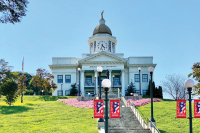Legislative tour focuses on lingering flood impact
 Five state legislators, including (left to right) Mike Clampitt, Mark Pless, Karl Gillespie, John Bell and Jennifer Balkcom visited flood-damages sites across Haywood County.
Cory Vaillancourt photo
Five state legislators, including (left to right) Mike Clampitt, Mark Pless, Karl Gillespie, John Bell and Jennifer Balkcom visited flood-damages sites across Haywood County.
Cory Vaillancourt photo
Nearly two years after rains from Tropical Storm Fred inundated Haywood County and flooded parts of Bethel, Canton, Clyde and Cruso, important infrastructure projects are continuing with significant help from the North Carolina General Assembly.
On April 17, Rep. Mark Pless (R-Haywood) brought legislators from across the state to show them firsthand the work that remains.
“One of the hardest things about recovery from such a tragic event is knowing exactly what needs to be done,” Pless said. “Over the last year, year-and-a-half, we have worked hard to find what the problems are, we’ve worked hard to address the issues, we’ve thrown a lot of money this way and now we’re fine-tuning how that’s going to look.”
The rest of far Western North Carolina’s House delegation showed up in support of Pless, including reps Mike Clampitt (R-Swain) and Karl Gillespie (R-Macon). Pless also welcomed Rep. Jennifer Balkcom (R-Henderson) and House Majority Leader John Bell (R-Wayne), who with Pless chairs the disaster recovery and homeland security committee.
A number of local government officials from Canton, Clyde, Haywood County, Haywood Schools and the Haywood County Sheriff’s Office took part in the tour, which began in the parking lot of Canton’s old town hall.
All projects in the town of Canton — town hall, the police and fire departments, the armory and the Colonial Theatre — have been funded, but Pless started the tour there to show his fellow legislators the scope of the destruction. A culvert on Rhoda Street that couldn’t handle the immense volume of floodwaters was the second stop, meant to illustrate what happens when water can’t get to a reservoir or basin.
Related Items
“Now they can look at it, and the legislature can understand why we need to make sure that we’re not just repairing damage, we’re doing it better this time so that we prevent damage the second time,” Pless said.
Like the downtown Canton projects, the Rhoda Street project is funded; however, the rest of Pless’ tour was a multi-million-dollar to-do list focusing on both recovery and resiliency.
In Hidden Valley, abandoned homes still sit amid fields of rubble and wrecked vehicles. They’re a poignant reminder of when the Pigeon River slammed into the small working-class neighborhood tucked in between Cruso Road and Max Thompson Road.
It will happen again, but next time, Pless wants to be sure the damage isn’t as severe. He wants buyouts, and wants to be sure nothing will be built there ever again. The area could become a wetland or be returned to agricultural use so long as the farmers understand that they could one day lose everything.
“We don’t know exactly how much the buyouts are going to cost at this point, so we don’t know how much money we need,” Pless said. “I know that money that is in Raleigh right now that we appropriated, I have some flexibility. If I can get some of that shifted around, we’re looking at $5 or $6 million to start so that we can go ahead and go down that road. And we’re going to add more money to it once we realize how much it’s going to cost to actually do the buyouts.”
From there it was off to the bridge on Hungry Creek Road, which spans the river.
“Hungry Creek is an example of what happens when we don’t put the streams back where they originally were,” Pless said, noting the flooding that took place in 2004. “Now what we’re seeing is, the river is migrating to one side or the other, which changes what floods next time. We have to have a plan to put these streams back. That’s why the American Flood Coalition was here, to help us understand how we need to build back and get the streams where they came from.”
The American Flood Coalition is a nonprofit comprised of local, state and national elected officials as well as leaders in the business community and the military that advocates resiliency-based solutions to emerging environmental issues. Representatives of the group have visited Canton multiple times since 2021.
“The issue of flood resiliency, flood recovery — that is truly a statewide issue, because the need is truly statewide,” said Tony McEwen, Carolinas director of the AFC. “It’s not just a coastal issue. We’re actively working with legislators in Raleigh to make sure that the existing funding streams and future funding streams, as well as flood policy in general, bears in mind the kind of unique issues that you face here in Western North Carolina.”
On Cruso Road, where it intersects with Rattlesnake Branch Road, there’s a stunning view of the river below demonstrating how the flood changed its course and where, exactly, it imperils the roadway.
“Rattlesnake Cove is a big deal. It’s an area that the roadway is going to erode again because the river turns as it comes in. Any time we get a heavy rain, it causes more of that bank to come off. It’s dangerous to the folks that live there but it’s more dangerous in the fact that eventually another storm is going to hit it and it’s going to wipe that road out completely,” Pless said. “If we can go in and get some transportation funding, get some engineers up here from DOT, figure out a way to get that reinforced and shored up and get maybe even get the river diverted away from it, we can protect that area.”
Protecting the area as a whole also means looking at first responders and their needs; Pless, who is formerly EMS, and Clampitt, a retired fire captain, both took great interest in what happened at Cruso’s fire station 2.
During the flood, water penetrated the building on Michael Road. Firefighters were able to get one of the trucks out in time, but another ended up stranded in 4 feet of water in the garage. Both the truck and the building need to be replaced.
“Cruso doesn’t have the budget to go in and replace stations and move stuff around. We’re going to try to help them get up out of the floodway, so that from now on, they can respond and do what they need to do, but do it from a safe location,” Pless said.
Finally, the tour wound up at Central Haywood High School in Clyde. The school sits right on the Pigeon River, not far from the bridge where hundreds upon hundreds of green peppers, violently stripped from their stems by fast-moving floodwaters, washed up.
But the school is also part of a larger facility that houses not only the school board’s meeting room, which has now been flooded twice, but also the school system’s information technology department.
Classes are currently being held at the former Central Elementary site in Waynesville, which Pless says isn’t ideal.
“We need them back in Clyde,” he said. “The school board doesn’t have the money. The county doesn’t have the money with everything that’s going on with the mill and the possibility of them closing. We need to be able to get them moving forward and I think we need to get them off the river so that it never floods again.”
Balkcom said that the county she represents, Henderson County, experiences periodic flooding from the French Broad River and that there are also infrastructure issues there that need to be fixed.
“I think the big thing is being prepared, setting money aside knowing that this happens maybe two or three times a year,” she said. “Being prepared for it makes a world of difference.”
Bell said he’d been looking at Haywood County’s flood damage on paper for more than a year, but that seeing in person made quite an impact.
“My brain has been turning the whole trip on how we can reclassify terminology on different pieces of legislation to help Western North Carolina tap into some of the same funding that eastern North Carolina has had,” he said. “I think that when we get back to Raleigh, we’ll sit down with Rep. Pless sometime this week and will figure out some ways that we can go ahead and quickly address some of the problems that I’ve seen today.”









